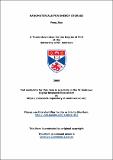Nanomaterials for energy storage
Abstract
The results presented in this thesis demonstrate the first synthesis of several nanostructured transition metal oxides and lithium containing transition metal oxides. Their uses in lithium-ion batteries and/or as magnetic materials have been investigated.
The first example of two and three dimensional mesoporous Fe₂O₃ has been prepared by using the soft templating (surfactant) method. The materials have amorphous walls and exhibit superparamagnetic behaviour.
By using a hard template route, a mesoporous α-Fe₂O₃ with highly crystalline walls has been synthesized. Its unique magnetic behaviour, distinct from bulk α-Fe₂O₃, nanoparticulate α-Fe₂O₃, and mesoporous Fe₂O₃ with disordered walls, has been demonstrated.
The hard template method was also used to prepare nanowire and mesoporous Co₃O₄, β-MnO₂ and MnO₃ with crystalline walls. Their electrochemical properties as electrodes in Li-ion batteries have been investigated. Mesoporous β-MnO₂ can accommodate 0.9 Li/Mn in stark contrast to bulk β-MnO₂ which cannot accommodate Li.
To prepare mesoporous materials which cannot be obtained directly by the hard template method, a post-templating route has been developed. Mesoporous Fe₃O₄, γ-Fe₂O₃, and Mn3O4 with ordered mesostructures and highly crystalline walls have been obtained by post-synthesis reduction/oxidation treatments. All the materials show unique magnetic properties compared with nanoparticulate and bulk materials.
Also, the first example of lithium containing mesoporous material, LT-LiCoO₂, was synthesized by first preparing mesoporous Co₃O₄, then reacting this with LiOH to form LT-LiCoO₂, with retention of the ordered nanostructure. The nanostructured LT-LiCoO₂ compounds demonstrate superior performance compared with normal or nanoparticulate LT-LiCoO₂, when used as intercalation electrodes in lithium batteries.
Finally, monodispersed Mn₃O₄ nanoparticles (diameter ~ 8 nm) with a core-shell structure (a highly crystalline Mn₃O₄ core encased in a thin MnO₂ shell) have been prepared for the first time. Ordered three-dimensional arrays form by spontaneous self-assembly. Magnetic measurements demonstrated that the self-assembled three-dimensional arrays exhibit spin-glass behaviour, rather than the anticipated superparamagnetic behaviour for isolated nanoparticles. Such behaviour is interpreted as arising from strong interactions between the core (crystallized Mn₃O₄) and shell (MnO₂).
Type
Thesis, PhD Doctor of Philosophy
Collections
Items in the St Andrews Research Repository are protected by copyright, with all rights reserved, unless otherwise indicated.

